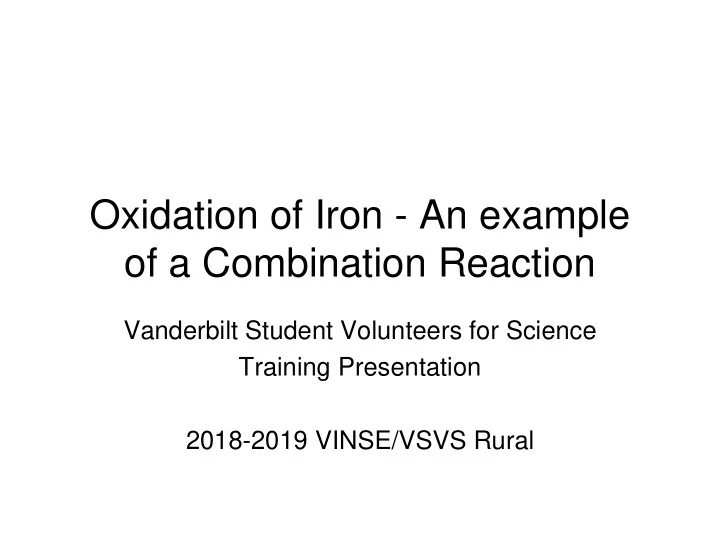

Oxidation of Iron - An example of a Combination Reaction Vanderbilt Student Volunteers for Science Training Presentation 2018-2019 VINSE/VSVS Rural
Introduction • Ask students if they know what oxidation is? What are some things that oxidize ? • Oxidation: Oxidation usually occurs when an element or compound combines with oxygen . – Apples turn brown after they have been cut and left exposed to the air. – Iron is oxidizing when it rusts and turns a reddish color • Tell students we are going to investigate the oxidation of iron, commonly called rusting. • This example of rusting is called a combination reaction • A Combination Reaction is a reaction where two or more reactants are chemically bonded together to produce a single product. • Rust is the common name for a very common compound, iron oxide. • Rusting is a very slow process which takes place over several weeks or months.
Experiment 1: Rusting of Iron Filings 1. Put cotton ball into a 1oz cup and sprinkle with iron filings. 2. Sprinkle a small scoop of salt 3. Add a squirt of Hydrogen Peroxide 4. Set aside and observe after starting part 2. An obvious orange color forms within 2-5 minutes.
Experiment 2: Iron Filings Oxidation an Exothermic Reaction 1. Put iron filings into plastic bag 2. Put plastic bag into cup (line it like a garbage can) 3. Add a spoonful of salt and the rest of the peroxide. 4. Feel the bag and note the temperature (Should be at room temperature). Measure the temperature with the thermometer . 5. 6. Students will measure the temperature again in 1 minute Observations will include: Solution is becoming orange colored. Solution is bubbling (producing a gas). Temperature will probably not show any increase yet Line like a garbage can
Looking back at Experiment 1 • Based on the color of the product, ask students to hypothesize which iron oxide has formed (look at the iron oxide vials in the first part of the lesson). • Equation: 4Fe + 3O 2 2Fe 2 O 3 • Why is this classified as a combination reaction? • What is an oxidation reaction? Before: no rust After: orange color
Return to Experiment 2. 1. Measure the temperature of the liquid in the plastic bag now. 2. Students should observe an increase of 10-20 degrees C. 3. The temperature of the iron filings plus peroxide plus salt mixture increases, so the reaction is EXOTHERMIC.
Is it a Chemical Reaction? • Ask students what evidence there is for a chemical reaction taking place? – A change in color (rust is reddish) is evidence of a chemical change. – A new substance is formed. – Gas (bubbles) is being given off (from the decomposition of hydrogen peroxide.) – There is a temperature change. Rusting is exothermic. It usually happens so slowly that it is not noticed.
Clean Up • Rinse and dry the thermometers. • Seal plastic bags and throw away in trash can. • Try NOT to get 10 oz cups contaminated with iron oxide liquid – it stains.
Recommend
More recommend